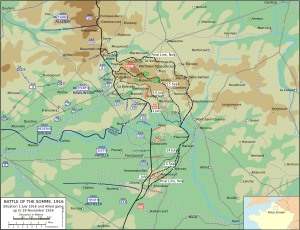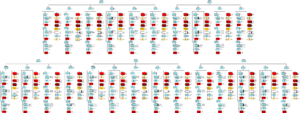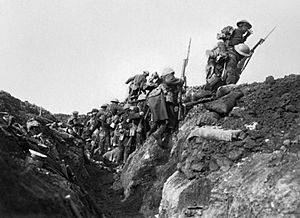Order of battle for the Battle of the Somme facts for kids
Quick facts for kids Battle of the Somme |
|||||||
|---|---|---|---|---|---|---|---|
| Part of the Western Front of the First World War | |||||||
 Battle of the Somme 1 July – 18 November 1916. |
|||||||
|
|||||||
| Belligerents | |||||||
|
|
||||||
| Commanders and leaders | |||||||
| Strength | |||||||
| 13 British, 11 French divisions 1 July 51 British, 48 French divisions July–November |
10+1⁄2 divisions 1 July 50 divisions July–November |
||||||
| Casualties and losses | |||||||
| 623,907 | c. 237,000–500,000 | ||||||
The Battle of the Somme was one of the biggest and bloodiest battles of World War I. It took place on the Western Front in France from July 1 to November 18, 1916. This battle involved forces from France, the British Empire (including soldiers from Canada, Australia, New Zealand, South Africa, and India), and Germany.
Contents
- Understanding the Battle of the Somme
- What Was the Battle of the Somme?
- Who Fought in the Battle?
- How Armies Were Organized
- Key Battles and Stages
- Battle of Albert: July 1–13
- Attack on the Gommecourt Salient: July 1
- Battle of Bazentin Ridge: July 14–17
- Attack at Fromelles: July 19
- Attacks on High Wood: July 20–25
- Battle of Delville Wood: July 15 – September 3
- Battle of Pozières: July 23 – September 3
- Battle of Guillemont: September 3–6
- Battle of Ginchy: September 9
- Battle of Flers-Courcelette: September 15–22
- Battle of Morval: September 25–28
- Battle of Thiepval: September 26–28
- Battle of Le Transloy: October 1–18
- Battle of the Ancre Heights: October 1–18
- Battle of the Ancre: November 13–16
- Royal Flying Corps
Understanding the Battle of the Somme
What Was the Battle of the Somme?
The Battle of the Somme was a major attack by the Allied forces (British and French) against the German army. It happened near the Somme River in northern France. The goal was to break through German lines and relieve pressure on the French army fighting at Verdun.
Who Fought in the Battle?
On one side were the Allied forces, mainly from the French and British Empire. This included soldiers from many countries like Canada, Australia, New Zealand, and South Africa. On the other side was the German Empire.
How Armies Were Organized
Armies in World War I were very large and complex. They were divided into different groups to help manage them.
British and Dominion Forces
The British army had different types of soldier groups:
- Regular Army: These were professional soldiers who were already part of the army before the war.
- New Army ("Kitchener's Army"): These were new soldiers who joined up after the war started. Many volunteered because they felt it was their duty.
- Territorial Force: These were part-time soldiers who trained in their local areas. They usually served in the United Kingdom, but many volunteered to fight overseas during the war.
- Dominion Forces: These were soldiers from countries that were part of the British Empire, like Canada, Australia, New Zealand, and South Africa. They fought alongside British troops.
These groups were organized into larger units:
- Battalions: A battalion was a group of about 1,000 soldiers.
- Brigades: Several battalions formed a brigade.
- Divisions: Several brigades formed a division, which was a very large group of soldiers (around 10,000 to 20,000).
- Corps: Several divisions formed a corps.
- Armies: Several corps formed an army, which was the largest group of soldiers in a specific area of the front.
French Forces
The French army also had a similar structure. Many of their divisions had three regiments, and each regiment had three battalions. French divisions often rotated through battles, meaning many of their soldiers had experience from other fights like the Battle of Verdun.
German Forces
The German army also used a similar system of organizing their soldiers into battalions, regiments, divisions, and corps. They had different types of divisions, including regular "Line" divisions, "Guards" divisions (elite units), and "Reserve" divisions.
Key Battles and Stages
The Battle of the Somme wasn't just one big fight. It was a series of smaller battles that took place over several months. Here are some of the main stages:
Battle of Albert: July 1–13
This was the first part of the Somme offensive. British and French forces tried to break through German lines.
- Capture of Montauban
- Capture of Mametz
- Capture of Fricourt
- Capture of Contalmaison
- Capture of La Boisselle
Attack on the Gommecourt Salient: July 1
This was a smaller attack meant to distract German forces from the main Somme offensive.
Battle of Bazentin Ridge: July 14–17
After the first push, the Allies launched another attack to gain more ground.
- Capture of Longueval
- Capture of Trônes Wood
- Capture of Ovillers
Attack at Fromelles: July 19
Another diversionary attack, this one was very costly for the Allied forces.
Attacks on High Wood: July 20–25
Fierce fighting took place in and around High Wood as both sides tried to control this important area.
Battle of Delville Wood: July 15 – September 3
This was a long and brutal fight for control of a small forest, known for its intense combat.
Battle of Pozières: July 23 – September 3
Australian and British forces fought to capture the village of Pozières and nearby areas.
- Fighting for Mouquet Farm
Battle of Guillemont: September 3–6
Allied forces continued their push, trying to capture more villages.
Battle of Ginchy: September 9
Another village capture attempt, part of the ongoing offensive.
Battle of Flers-Courcelette: September 15–22
This battle was notable for being the first time tanks were used in warfare.
- Capture of Martinpuich
- Capture of Le Sars
Battle of Morval: September 25–28
Allied forces continued to advance, capturing more strategic points.
- Capture of Combles
- Capture of Lesbœufs
- Capture of Gueudecourt
Battle of Thiepval: September 26–28
This battle focused on capturing the strong German defenses around Thiepval.
Battle of Le Transloy: October 1–18
Fighting continued into the autumn, with difficult conditions.
- Capture of Eaucourt l'Abbaye
- Capture of Le Sars
- Attacks on the Butte de Warlencourt
Battle of the Ancre Heights: October 1–18
This involved more fighting for fortified German positions.
- Capture of Schwaben Redoubt
- Capture of Stuff Redoubt
- Capture of Regina Trench
Battle of the Ancre: November 13–16
This was one of the last major attacks of the Somme offensive, happening in cold and muddy conditions.
- Capture of Beaumont-Hamel
Royal Flying Corps
The Royal Flying Corps (RFC) was the air force of the British Army during World War I. They played an important role in the Battle of the Somme by observing enemy positions, taking photos, and sometimes engaging in air combat. Several squadrons were involved, including:



